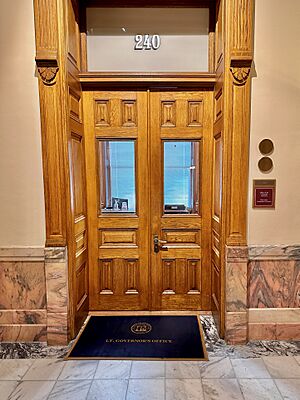Lieutenant Governor of Georgia facts for kids
Quick facts for kids Lieutenant Governor |
|
|---|---|

|
|
| Government of Georgia | |
| Appointer | Elected by popular vote |
| Term length | 4-years, no term limit |
| Inaugural holder | Melvin E. Thompson |
| Formation | August 13, 1945 |
| Succession | First |
| Salary | $54,920 (2023) |
The lieutenant governor of Georgia is an important elected official in the State of Georgia. This person is chosen by the people in an election every four years. Unlike in some other states, the lieutenant governor is elected separately from the governor. This means voters choose them on different ballots.
The main job of the lieutenant governor is to lead the Senate in Georgia. The Senate is part of the state's law-making body. If the governor cannot do their job, the lieutenant governor steps in. They take over the governor's duties and powers. If the governor leaves office permanently, the lieutenant governor becomes the new governor. They serve for the rest of that term.
The position of Lieutenant Governor was created in 1945. Before that, Georgia did not have this office. The first lieutenant governor, Melvin E. Thompson, was elected in 1946. He was involved in a famous event called the three governors controversy.
The person currently serving as the lieutenant governor of Georgia is Burt Jones. He is a member of the Republican Party.
Contents
How the Office of Lieutenant Governor Began
The job of lieutenant governor in Georgia started in 1945. This happened when the state's constitution was updated. The main reason for creating this role was to have someone ready to take over if the governor's office became empty.
Melvin E. Thompson was the first person elected to this office in 1946. He served only a short time, from January to March 1947. He then became governor due to a special situation. This situation was known as the three governors controversy.
Later, Marvin Griffin was elected lieutenant governor in 1948. He started some traditions for the role. He became a strong leader in the State Senate. He also helped choose who would lead Senate committees. Over time, the rules for this role have changed. In 2010, the Senate changed its rules again. This change meant the lieutenant governor could no longer choose the members of Senate committees.
How the Lieutenant Governor Is Elected
To become lieutenant governor, a person must meet certain requirements. They must have been a citizen of the United States for at least 15 years. They also need to have lived in Georgia for at least six years before the election.
The lieutenant governor is elected on their own ballot. This is separate from the election for governor. There is no limit to how many terms a person can serve. This means they can be re-elected many times.
What the Lieutenant Governor Does
The Georgia State Constitution explains the lieutenant governor's main duties. Their most important job is to be the President of the Senate. This means they lead the discussions and debates in the Senate.
The lieutenant governor also takes over if the governor's office becomes empty. This can happen if the governor dies or cannot do their job. The State Supreme Court decides if the governor is unable to serve. If this happens, the lieutenant governor takes on the governor's powers and duties. They serve until the next general election.
As the President of the Senate, the lieutenant governor guides the Senate's work. However, they are not a member of the Senate themselves. This means they cannot suggest new laws. The Senate rules give the president some power. They appoint two senators to a special committee. They also lead this committee, but only vote if there is a tie. The president also helps manage other Senate affairs. They make sure new bills are sent to the correct committees. They also oversee a program for Senate pages. Pages are young people who help out in the Senate. Even though the lieutenant governor leads the Senate, the Senate can choose to make its own decisions.
List of Lieutenant Governors of Georgia
Political Parties
Democratic (10) Republican (3)
| No. | Lt. Governor | Term in office | Party | Election | Governor | |||
|---|---|---|---|---|---|---|---|---|
| 1 |  |
Melvin E. Thompson | January 14, 1947 – March 18, 1947 |
Democratic | 1946 | Herman Talmadge | ||
| — | Office vacant from March 18, 1947 - November 17, 1948 | — | Melvin E. Thompson | |||||
| 2 |  |
Marvin Griffin | November 17, 1948 – January 11, 1955 |
Democratic | 1948 (special) |
Herman Talmadge | ||
| 1950 | ||||||||
| 3 |  |
Ernest Vandiver | January 11, 1955 – January 13, 1959 |
Democratic | 1954 | Marvin Griffin | ||
| 4 |  |
Garland T. Byrd | January 13, 1959 – January 15, 1963 |
Democratic | 1958 | Ernest Vandiver | ||
| 5 |  |
Peter Zack Geer | January 15, 1963 – January 11, 1967 |
Democratic | 1962 | Carl Sanders | ||
| 6 |  |
George T. Smith | January 11, 1967 – January 12, 1971 |
Democratic | 1966 | Lester Maddox | ||
| 7 |  |
Lester Maddox | January 12, 1971 – January 14, 1975 |
Democratic | 1970 | Jimmy Carter | ||
| 8 |  |
Zell Miller | January 14, 1975 – January 13, 1991 |
Democratic | 1974 | George Busbee | ||
| 1978 | ||||||||
| 1982 | Joe Frank Harris | |||||||
| 1986 | ||||||||
| 9 |  |
Pierre Howard | January 13, 1991 – January 11, 1999 |
Democratic | 1990 | Zell Miller | ||
| 1994 | ||||||||
| 10 |  |
Mark Taylor | January 11, 1999 – January 8, 2007 |
Democratic | 1998 | Roy Barnes | ||
| 2002 | Sonny Perdue | |||||||
| 11 |  |
Casey Cagle | January 8, 2007 – January 14, 2019 |
Republican | 2006 | |||
| 2010 | Nathan Deal | |||||||
| 2014 | ||||||||
| 12 |  |
Geoff Duncan | January 14, 2019 – January 9, 2023 |
Republican | 2018 | Brian Kemp | ||
| 13 |  |
Burt Jones | January 9, 2023 – Incumbent |
Republican | 2022 | |||
Related Government Bodies
- Georgia Senate
- Georgia House of Representatives
- Georgia General Assembly



